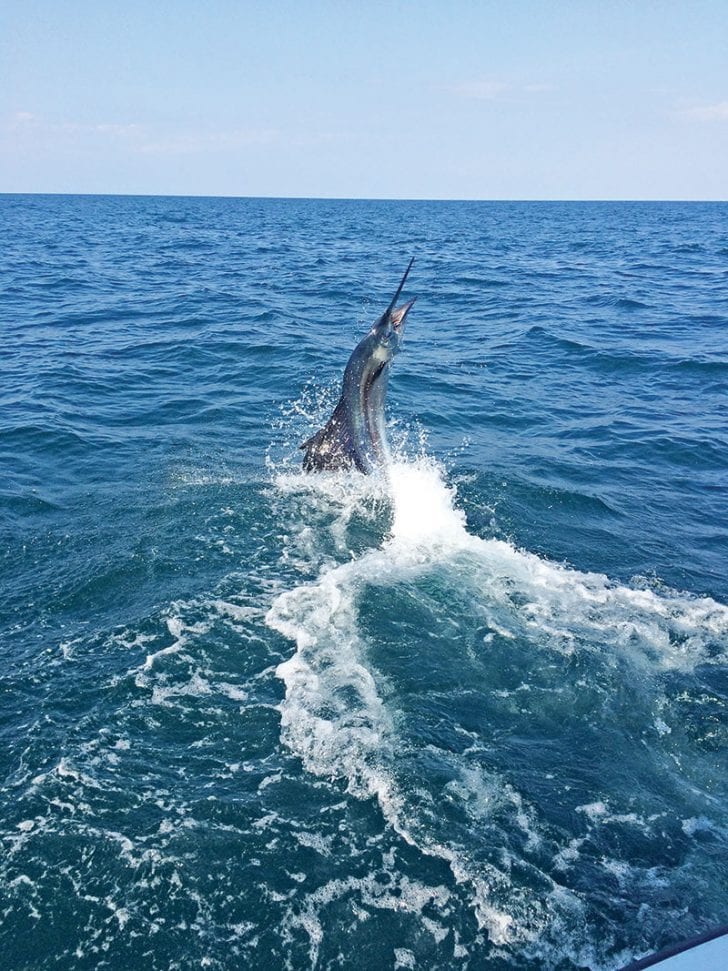
Novembers’ cooler temperatures trigger the fall bait migration that leads to loads of baitfish pushing through South Florida. Among these baitfish, none are more prevalent than pilchards and ballyhoo. Pilchards are usually found inshore around grass flats, channels and bridges. One good throw of a 10’ to 12’ cast net can translated into a well full of these frisky baits. If you lack cast net skills and throw figure eights instead of pancakes, you always have the options of catching your bait using sabiki rigs. Despite being a much slower method for making bait, hook caught baits will usually perform better and last longer than netted bait.
Ballyhoo can be found inshore around channel markers or over shallow reefs on the ocean side. The three different techniques that can be used to catch ballyhoo are hook and line, cast net and hoop net. Just like pilchards, hooking and catching them one at a time helps improve their life span. Netting them knocks a lot of their slime and scales off and greatly stresses them. Personally, I like the hoop net whenever possible because I can catch them quickly with minimal stress to the bait.
Aside from ballyhoo and pilchards, other baits such as herring and goggle eyes still work on many occasions. Exactly how you present your baits will depend a lot on the wind and sea conditions. Obviously, on windy days you may want to kite fish while drifting or slow trolling along the edge. Look for lots of action in your spread from kingfish and sailfish. On days with strong east winds, some mahi may also be pushing through.
It is important to keep an eye out for spraying bait as this can signal feeding activity. Most of the time this will happen in those same shallow reefs that ballyhoo call home. A lot of the feeding activity will come from large spanish and cero mackerel slicing and dicing ballyhoo. You may also come across packs of sailfish trying to corral bait as they take turns at feeding. Last but not least, mahi may also be found in the powdery blue water chasing those same hoos.
The key here as with all other types of fishing is to match the hatch. In other words, if you’re pitching baits to feeding fish, make sure you throw what they are focused on. Casting a herring when they are eating ballyhoo may not produce the desired result. It is equally crucial to have a bait ready at all times since these fish will be moving fast.
During periods of high wind and seas a good option is to go mackerel fishing. Many of the inshore markers and channels hold lots of these fish and the action can be red hot. The key is to fish light tackle in combination with the right bait. Although mackerel readily eat artificials and even flies, nothing beats a well full of small and medium pilchards. The small white baits serve double duty as chum and bait. If the pilchards aren’t available, live shrimp work very well too. Most fish will be caught near the surface, so sinkers are a no-no.
Well, that is pretty much it for right now. Don’t forget that I will be presenting more FREE SEMINARS at Bass Pro Shops in Miami. You can keep up with everything by following us on FACEBOOK, Instagram and Twitter. If you like watching some of the action, be sure to check out my YOUTUBE page for the latest video additions.
Tight Lines,
CAPT. ORLANDO MUNIZ
Nomad Fishing Charters
786-266-0171
www.fishingchartermiami.com
SPONSORS AND FRIENDS: Mercury Marine, Bass Pro Shops, Offshore Angler, ACRARTEX, Orca Coolers, SeaDek, Costa Del Mar, AquaNutrition Tigress, Cudabrand, XTRATUF, and Baitmasters.

